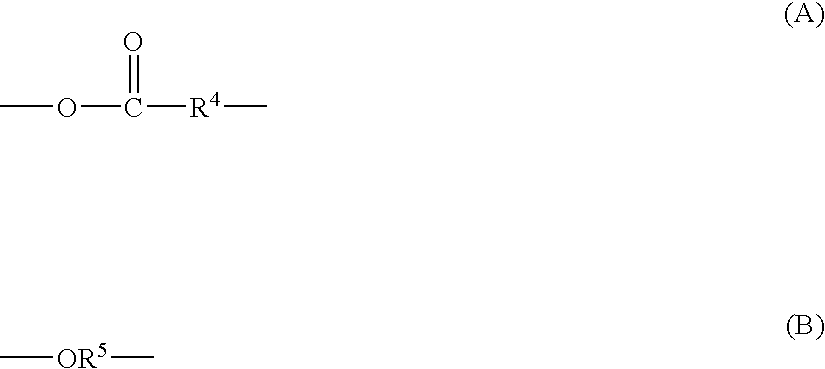Adherence substance, pressure sensitive adhesive sheet and its use
a technology of adhesive sheet and adhesive substance, which is applied in the direction of film/foil adhesive, polarising elements, synthetic resin layered products, etc., can solve the problems of odor or dermal irritation high migration rate, and easy odor of acrylic pressure sensitive adhesive, so as to achieve solvent-free, low viscosity, and good coatability
- Summary
- Abstract
- Description
- Claims
- Application Information
AI Technical Summary
Benefits of technology
Problems solved by technology
Method used
Image
Examples
reference preparation example 1
Preparation of Composite Metal Cyanide Complex Catalyst
[0227]By the following method, a zinc hexacyanocobaltate having tert-butyl alcohol as an organic ligand (hereinafter referred to as TBA-DMC catalyst) was prepared. In this Example, polyol X is a polyol having number average molecular weight (Mn1) of 1,000, obtained by addition-polymerizing propylene oxide to dipropylene glycol.
[0228]Firstly, in a 500 ml flask, an aqueous solution comprising 10.2 g of zinc chloride and 10 g of water, was put, and while stirring this aqueous solution at 300 rpm and maintaining it at 40° C., an aqueous solution comprising 4.2 g of potassium hexacyanocobaltate (K3[Co(CN)]6) and 75 g of water, was dropwise added over a period of 30 minutes. After completion of the dropwise addition, the mixture was further stirred for 30 minutes. Thereafter, a mixture comprising 40 g of ethylene glycol mono-tert-butyl ether (hereinafter abbreviated as EGMTBE), 40 g of tert-butyl alcohol (hereinafter abbreviated as TB...
preparation example 1
Preparation of Polyester Ether Type Silyl Group-Containing Polymer (S11-1)
[First Step]
[0231]Into a 10 L stainless steel pressure resistant reactor equipped with a stirrer, 2,800 g of a polyoxypropylene diol (hydroxy group-based Mw=700) as an initiator (z21) and TBA-DMC catalyst as a polymerization catalyst were introduced. The amount of the TBA-DMC catalyst was 50 ppm to the finish mass i.e. 50 ppm as the metal amount in the polymer upon completion of the first step.
[0232]After replacing the interior of the reactor with nitrogen, the temperature was raised to 140° C., and 280 g of PO was introduced into the reactor with stirring and reacted. This is a step to activate TBA-DMC catalyst by initially supplying a small amount of PO.
[0233]Then, after the pressure in the reactor decreased, 1,640 g of PO and 3,280 g of CL were introduced into the reactor at constant rates, respectively, with stirring, so that the supply amounts per unit time would be PO / CL=1 / 2 by mass ratio. After completi...
preparation example 2
Preparation of Polyether Type Silyl Group-Containing Polymer (S2-1)
[First Step]
[0237]In a 10 L stainless steel pressure resistant reactor equipped with a stirrer, 800 g of a polyoxypropylenediol (hydroxy group-based Mw=1,000) as an initiator (z2) and TBA-DMC catalyst as a polymerization catalyst were introduced. The amount of TBA-DMC catalyst was 50 ppm to the finish mass.
[0238]After replacing the interior of the reactor with nitrogen, the temperature was raised to 140° C., and 80 g of PO was introduced into the reactor with stirring and reacted. This is a step to activate TBA-DMC catalyst by initially supplying a small amount of PO.
[0239]Then, after the pressure in the reactor decreased, 7,120 g of PO was supplied with stirring and stirred for 11 hours while maintaining the stirring rate at 500 rpm and maintaining the temperature in the reactor at 140° C. thereby to let the polymerization reaction proceed, thereby to obtain polyol B.
[Second Step]
[0240]A polyether type silyl group-c...
PUM
| Property | Measurement | Unit |
|---|---|---|
| peel adhesive strength | aaaaa | aaaaa |
| hydroxy value | aaaaa | aaaaa |
| peel adhesive strength | aaaaa | aaaaa |
Abstract
Description
Claims
Application Information
 Login to View More
Login to View More - R&D
- Intellectual Property
- Life Sciences
- Materials
- Tech Scout
- Unparalleled Data Quality
- Higher Quality Content
- 60% Fewer Hallucinations
Browse by: Latest US Patents, China's latest patents, Technical Efficacy Thesaurus, Application Domain, Technology Topic, Popular Technical Reports.
© 2025 PatSnap. All rights reserved.Legal|Privacy policy|Modern Slavery Act Transparency Statement|Sitemap|About US| Contact US: help@patsnap.com



